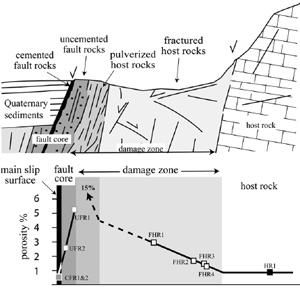| |||||||
|
|
|||||||
|
|
|||||||
| Porosity and Permeability of Sheared Pressure Solution Seam-based Faults in Carbonates | |||||||
|
Agosta (2006) and Agosta et al. (2007) presented porosity measurements of various components of a normal fault in platform carbonates, Fucino Basin, Central Italy. Both fault core and damage zone are divided into two parts (Figure 1 top): uncemented fault rock, cemented fault rock, pulverized rocks, and fractured rocks in damage zone.
The porosity of the host rock is low (0.8%). Without taking into account the small faults and opening fractures in the damage zone, the porosity of the fractured host rocks in the damage zone is higher (1.3 to 3%), and generally increases closer to the fault core. This correlation is shown in Figure 1. Porosity values of the pulverized rocks in the damage zone are missing. However, these rocks are cross-cut by cataclastic shear bands, which are common features in clastic rocks with porosity higher than 15% (Antonellini and Aydin, 1994). Agosta and co-authors projected the porosity value in pulverized rocks in the damage zone to be up to 15% (dashed line). Within the fault footwall, the porosity decreases in the fault core and eventually collapses to 0.6% near the main slip surfaces. Although the contact between cemented and uncemented fault rocks is shown as sudden and abrupt in Figure 1, at micro-scale it is often gradational. | |||||||
| Reference: |
|||||||
| Agosta, F., 2006 Agosta, F., Parasad, M., Aydin, A., 2007 Antonellini, M., Aydin, A., 1994 |
|||||||
|
Readme | About Us | Acknowledgement | How to Cite | Terms of Use | Ⓒ Rock Fracture Knowledgebase |
|||||||
